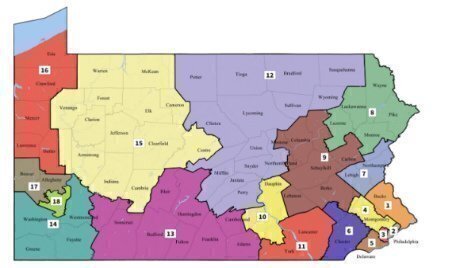Claiming full authority to do so, a deeply divided Pennsylvania Supreme Court drew up and released on Monday its own new map of congressional election districts – one that experts calculated would give Democratic candidates a realistic chance of picking up three or more seats than they have been able to win in the past three elections in the state.
 Republican leaders of the Pennsylvania legislature already had promised a challenge, in one or more courts, if the state’s highest court took on itself the task of drafting new election boundaries for the state’s 18-member delegation in the U.S. House of Representatives. Their main argument is expected to be that the state court had violated the federal Constitution by taking the task of redistricting away from the state legislature. That argument got some support Monday from one of the dissenting justices on the state court.
Republican leaders of the Pennsylvania legislature already had promised a challenge, in one or more courts, if the state’s highest court took on itself the task of drafting new election boundaries for the state’s 18-member delegation in the U.S. House of Representatives. Their main argument is expected to be that the state court had violated the federal Constitution by taking the task of redistricting away from the state legislature. That argument got some support Monday from one of the dissenting justices on the state court.
The state court’s new plan would replace a 2011 map that had resulted in Republicans winning 13 and the Democrats only five of the seats in U.S. House delegation, even though statewide voting for House candidates was close to evenly split. That was the outcome in elections in 2012, 2014 and 2016. The initial reaction of election experts Monday afternoon was that the new map could result in ten seats for Republicans and eight for Democrats; some analysts even suggested that, if there is a strong Democratic effort this year, the result could be an even split of nine-nine.
Any gains of significance in Pennsylvania could improve the Democratic Party’s national campaign to regain control of the House of Representatives. The primary election in Pennsylvania will go ahead as planned on May 15, with the general election on November 6.
Last month, the state’s highest court issued a split decision striking down the 2011 map as a “partisan gerrymander,” which it said was a clear violation of the state constitution’s guarantee of “free and equal” elections. In an opinion for a 4-to-3 majority, issued Monday along with the outlines of the new election boundaries, the court said that “it is clear that the 2011 plan [violates the state constitution] since a diluted vote is not an equal vote.”
A state court decision interpreting a state constitution is seldom second-guessed by federal courts, including the Supreme Court, and an attempt by state GOP leaders to get the Supreme Court to block the state court decision failed in a denial by Justice Samuel A. Alito, Jr. He acted without even consulting his eight colleagues.
After the state court struck down the 2011 map, it gave the state legislature 18 days to fix the constitutional violation. The two GOP leaders reported back to the court last week that there was not enough time for the legislature to create a new map, but those leaders submitted their own alternative plan that analysts said would still favor Republican candidates by a 13-to-5 split in outcomes.
Pennsylvania Gov. Thomas Wolf told the state court he opposed the GOP leaders’ version, and he along with those who had sued to challenge the 2011 map and others interested in the dispute, filed a series of maps. The state court’s own “remedial plan,” it said, was a better plan or at least as constitutionally acceptable a plan as those submitted to it.
The opinion accompanying the new map was unsigned by any of the four justices in favor of it. The opinion was issued “per curiam” – Latin for “for the court.”
Voting for the new map were Justices Christine Donohue, Kevin M. Dougherty, Debra McCloskey Todd and David N. Wecht. None of those four wrote separately. Dissenting were Chief Justice Thomas G. Saylor and Justices Max Bear and Sally Updyke Mundy, with each writing a dissenting opinion for themselves alone.
Justice Mundy wrote the strongest-worded dissent, noting that she had “concerns regarding the constitutionality of the judicially created congressional districts adopted today.” She said the federal Constitution assigned to state legislatures the task of congressional districting, and she contended that the legislature had not been given enough time by the state court to do its job. She added that the majority had not been cautious about “the preservation of the legislative process, as set forth” in the national Constitution.
The majority appeared to be answering Justice Mundy when it said it had “full constitutional authority and responsibility” under the state’s basic document to draw up a plan after the legislature failed to come up with a plan to remedy the violation.
Chief Justice Saylor, in dissent, wrote that it was unprecedented for a state court to “displace the political responsibility of redistricting” given to the legislature by the U.S. Constitution. He said the plan adopted by the majority was drafted by a political scientist assigned by the court to the task, and there were no hearings on the plan before it was adopted.
Justice Baer, who had previously agreed with the majority that the 2011 plan did violate the state constitution, had argued that a new plan should not be drawn for this year’s elections. While he said he opposed the majority’s decision to write its own plan, he said he was not taking a position on that map’s validity.
State GOP leaders of the legislature have strenuously fought the effort of the state court to prepare new congressional election boundaries, and have apparently already made plans to mount a challenge to it based on the federal Constitution’s assignment of the duty to redistrict congressional boundaries to state legislatures, with backup veto power only for Congress.
The GOP lawmakers are expected to attempt a challenge to the new map in a federal district court. In January, a three-judge district court in Philadelphia, dividing 2-to-1, rejected a challenge to the state’s 2011 congressional districting map; that ruling was based on the federal Constitution, and it found that there was no role for federal courts in enforcing the provision of Article I that assigns congressional districting to state legislatures.
While that ruling had nothing to do with the separate challenge in the state Supreme Court, it may have encouraged the GOP leaders that they could mount an Article I challenge to the Pennsylvania state court if it did undertake to draw up its own congressional map.
Both sides in the federal court case have filed formal appeals to the Supreme Court, but so far have filed no follow-up legal papers with the Justices.
Legendary journalist Lyle Denniston has written for us as a contributor since June 2011 and has covered the Supreme Court since 1958. His work also appears on lyldenlawnews.com.






